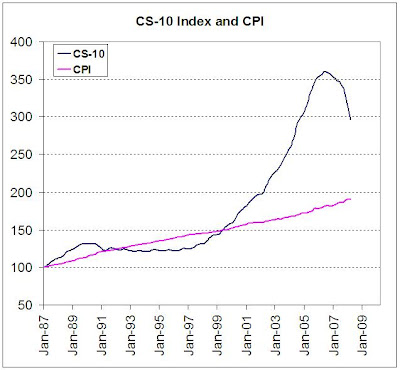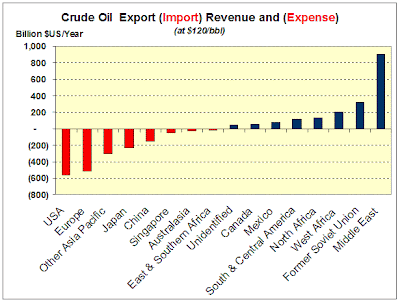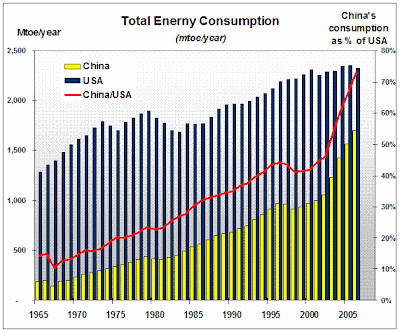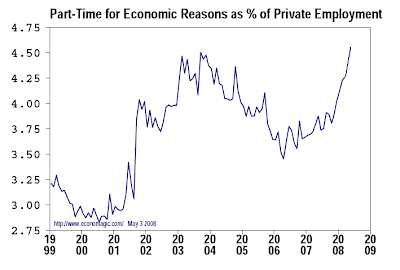But before delving into that, a current
Reuters news story about GE Money ceasing to finance motor homes and recreational boats. Sales of such pricey toys have collapsed: year-to-date motorhome shipments are down 24% and sales at the nation's largest boat retailer are down 28% in the first quarter. Along with Starbucks overpriced lattes, these are additional signs that the
US consumer is hitting the brakes hard.
And while peripheral, highly discretionary items are feeling the impact hardest, overall spending is down significantly, too. According to SpendingPulse, retail sales excluding gasoline and autos were down 0.7% in April versus March.
OK, back to the
Foreign Affairs article from 2000. You can read a 500 page preview
here (or the entire article if you are a subscriber).
This is a part of the first paragraph:
But contrary to much received wisdom, the energy problem looming in the early 21st century is neither skyrocketing prices nor shortages that herald the beginning of the end of the oil age. Instead, the danger is precisely the opposite; long-term trends point to a prolonged oil surplus and low oil prices over the next two decades [emphasis added].
The writers predicted oil would remain in the $12-20 range for another 20 years.
Instead, we got this:

The purpose of this post is not to scoff at a glaringly wrong prognosis by two experts - anyone can make a mistake. Indeed, it is sometimes far easier for "experts" to make mistakes than rank novices (ever heard of beginners' luck?). Instead, this post is about a different interpretation of the what, why and when of the article, one that may also shed some light at
current oil prices.
First, some background: by 1998-2000 oil prices were scraping the teens and low twenties for over a decade. The national economies of crucial Arab allies like Saudi Arabia, plus Russia (a.k.a. "Upper Volta with nukes") were essentially bankrupt. Populations in Arab oil producing nations exploded upwards while oil income collapsed, threatening the socio-political stability of the authoritarian regimes. Massive subsidies for everything from food, fuel and higher education, medical care and even wedding dowries were no longer possible. Agitation by young, restless populations was on the rise...
I remember reading the article when it first came out. My first reaction was surprise at the truly parlous state of finances in the Gulf region. In Saudi Arabia alone, real GDP per capita had slumped from $11,450 in 1984 to $6,750 in 1994. The country's budget had swung from $140 billion in surplus revenue in 1982 to consecutive deficits that eventually ran up a national debt of $130 billion. Other oil producers - most obviously Russia - were in even worse shape.
My second thought, then, was that
"they" wanted oil prices to go higher in order to prevent major geopolitical upheaval (
"they" being the loose term employed when referring to the US establishment, for which
Foreign Affairs is the recognized house organ). The article's purpose, therefore, was not to
predict low oil prices but to
warn that low prices were dangerous and no longer desirable. Indeed, after a brief pause due to the shallow recession following the dotcom bubble, prices climbed inexorably higher.
Well, things have now come full circle. The latest issue of
Foreign Affairs carries an article (
"Blood Barrels") that is in the
exact opposite direction of the one that appeared eight years and $100 ago. The summary reads:
Oil wealth often wreaks havoc on a country's economy and politics, helps fund insurgents, and aggravates ethnic grievances.
From cursing very low oil prices in 2000,
"they" have now gone to "..the so-called oil curse", "Dutch disease" and armed conflict by internal insurgencies. In the 3,000 word article "conflict" appears 17 times, "war" 11 times, insurgent/insurgency 7 times and violent/-ence 4 times. Get the message?
Now, all of the above is not meant as my prediction that oil prices will move lower - I am just pointing out the ebb and flow of the establishment's views on the subject. In any case, readers know that I prefer pricing energy on a like-for-like basis (EROEI), instead of artificial dollar terms that can expand or contract with monetary policy.
One final observation.
President Bush is to visit Israel, Saudi Arabia and Egypt between Wednesday, May 14 and Sunday, May 18. This is
the schedule:
Wednesday - Israel
Thursday - Israel
Friday (until abt. noon) - Israel
Rest of Friday - Saudi Arabia
Saturday - Egypt
Sunday - Egypt
If you are familiar with diplomatic protocol you can immediately "read between the lines". A visit to Saudi Arabia lasting just a few hours scrunched between Israel and Egypt is the equivalent of expressing severe displeasure, i.e. the White House is flipping Saudis the finger (
or is it the other way around?). The cause for such displeasure is easy to guess: despite repeated US entreaties to raise oil production and lower prices, the Saudis are staying put. They blame record prices on the lower dollar, speculative frenzy in futures markets and high demand from Asia, but the US administration is clearly not satisfied.
There are more aspects to this story, most prominently the possibility that Saudi oil production has peaked (see Simmon's
Twilight In The Desert). But "they" are very far from acknowledging any such possibility, at least publicly, choosing instead to view high oil prices as a deliberate choice by Arabs bent on maximizing current gain and "buying up the world" through sovereign wealth funds.
My view is that we will find out very, very soon what is
really going on.
 Data: Newspaper Assn. of America
Data: Newspaper Assn. of America It's unlikely that health obsessed Americans would ever eat fish 'n chips wrapped in yesterday's newsprint soaked in vinegar, but don't news-papers have certain qualities that transcend the electronic media? Reading at the beach comes immediately to mind, but there are surely others - aren't there?
It's unlikely that health obsessed Americans would ever eat fish 'n chips wrapped in yesterday's newsprint soaked in vinegar, but don't news-papers have certain qualities that transcend the electronic media? Reading at the beach comes immediately to mind, but there are surely others - aren't there?






























